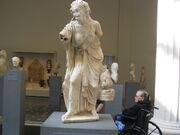The Hellenistic Period was an era in Ancient Greece from 323-30 BCE that followed the Classical Period.[1]
During the Hellenistic Period, the culture of the different regions of the cosmopolis that was created as a result of Alexander the Great's tremendous conquest fused to become a universal culture to the empire: Hellenism. After Alexander's death, the empire was split into three areas: Macedonia-Greece, Persia, and Egypt. Cultural diffusion occurred throughout the empire when people of different ethnicities and backgrounds traveled around the empire, spreading ideas and philosophies.[2]
The cultural diffusion that occured during the Hellenistic Period is best represented in the art forms of that time. Sculpture did not primarily focus on ideal nude, sensuous men and women, but all kinds of people including the eldery, children, and the deformed. Rather than idealism and realism that dominated the previous Archaic and Classical Periods respectively, humanism was the primary component to Classical sculpture.[3]
Hellenistic Art of the Metropolitan Museum[]

Hellenistic Period marble statue of youthful Hercules, 98-68 BCE

Hellenistic Period marble statue of old woman, 200-100 BCE
The photograph directly on the right is of a sculpture from the Hellenistic Period of Hercules. It was sculpted between 98-68 BCE. Hercules is obviously from the Hellenistic Period because of several physical and emotional aspects of the sculpture. Humanism is clearly exhibited in Hercules due to the sculptor's use of contrapposto in the shoulders and the legs, as well as a muscular, defined body. Additionallly, the drapings he is carrying are done by a technique of art only developed in the Hellenistic Period. Any sculpture that expresses human emotion that has some sort of use of drapings is obviously from the Hellenistic Period. These details may appear to be examples of realism, rather than humanism, but the drapings are the key to determining whether the sculpture is Hellenistic or not.[4]
The bottommost photograph on the right is of an old beggar woman. This sculpture was crafted in the 2nd century BCE (200-100). Once again, one can determine that this sculpture is Hellenistic by looking at the drapings that the old woman is wearing. Drapings were a relatively new sculpting technique in the Hellenistic Period. Furtherore, the sculpture is of an old, deformed beggar, rather than an ideal, physically built man or beautiful, ideal woman. In the Hellenistic Period, the focus of human sculptures varied, so there were sculptures of the elderly, children, and the deformed.[5] Finally, the humanistic aspect of this sculpture is quite obvious. The expression in the beggar's face is of sheer, utter hopelessness and despair, which has repercussions throughout her body, which is hunched over and weak in defeat. This emotional aspect to art was usually only found in Hellenistic sculptures. Therefore, this sculpture is without a doubt, Hellenistic.
The interchanging focuses of Ancient Greek art is relative to the events that were going on during this time. In the Archaic Period, sculptures of humans were idealistic, probably due to the Pan Hellenism and patriotism that the Greek people were experiencing. They felt superior and felt close to the divine, so their art reflected their feelings and the norm. The Classical Period was more realistic, as the Greek people realized what humans themselves were capable of, especially during the two wars. Finally, Hellenistic art reflected the human interest and curiosity about themselves, which derived from the intermixing of cultures in the giant cosmopolis that Alexander the Great established.
Citations[]
- ↑ Gloria Fiero, The Humanistic Tradition(New York: McGraw Hill, 2011), 130.
- ↑ Gloria Fiero, The Humanistic Tradition(New York: McGraw Hill, 2011), 130-131.
- ↑ Gloria Fiero, The Humanistic Tradition(New York: McGraw Hill, 2011), 134-135.
- ↑ Gloria Fiero, The Humanistic Tradition(New York: McGraw Hill, 2011), 134.
- ↑ Gloria Fiero, The Humanistic Tradition(New York: McGraw Hill, 2011), 134.